Current-Assisted SPAD with Improved p-n Junction and Enhanced NIR Performance
Abstract
:1. Introduction
2. Materials and Methods
Pixel Design and Simulations
3. Results and Discussion
3.1. Breakdown Voltage
3.2. Passive Quenching Circuit and Re-Triggering
3.3. Dark Count Rate
3.4. Afterpulsing
3.5. Photon Detection Probability
3.6. Timing Jitter
4. Conclusions
Author Contributions
Funding
Acknowledgments
Conflicts of Interest
Appendix A
Appendix A.1. Dark Count Rate

Appendix A.2. Afterpulsing
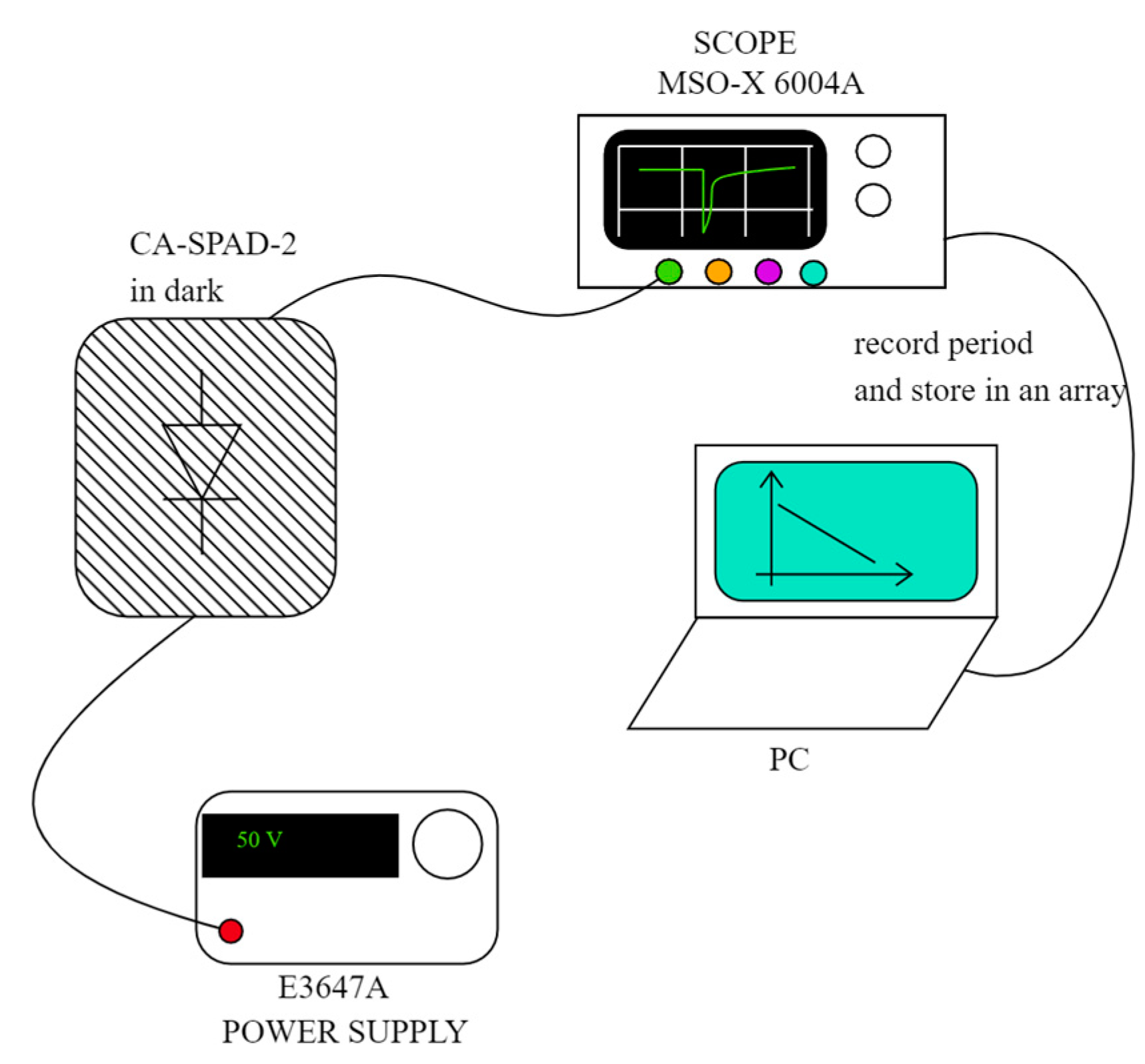
| Vex | Range | Bin Width |
|---|---|---|
| 1.5 V | 3 µs | 1 ns |
| 2.0 V | 2.5 µs | 1 ns |
| 2.5 V | 1.5 µs | 1 ns |
| Vex | a | b | APP (in%) |
|---|---|---|---|
| 1.5 V | 153 | 1.54 × 106 | 8 |
| 2.0 V | 255 | 2.57 × 106 | 10 |
| 2.5 V | 421 | 4.17 × 106 | 13 |
Appendix A.3. Photon Detection Probability

Appendix A.4. Light Emission Test
Appendix A.5. Data Analysis
References
- Morimoto, K.; Ardelean, A.; Wu, M.-L.; Ulku, A.C.; Antolovic, I.M.; Bruschini, C.; Charbon, E. Megapixel time-gated SPAD image sensor for 2D and 3D imaging applications. Optica 2020, 7, 346. [Google Scholar] [CrossRef]
- Ulku, A.C.; Ardelean, A.; Antolovic, I.M.; Weiss, S.; Charbon, E.; Bruschini, C.; Michalet, X. Wide-field time-gated SPAD imager for phasor-based FLIM applications. Methods Appl. Fluoresc. 2020, 8, 024002. [Google Scholar] [CrossRef]
- Charbon, E.; Fishburn, M.W.; Walker, R.; Henderson, R.K.; Niclass, C. TOF Range-Imaging Cameras; Springer Science and Business Media LLC: Berlin/Heidelberg, Germany, 2013; pp. 11–38. [Google Scholar]
- Bruschini, C.; Homulle, H.; Antolovic, I.M.; Burri, S.; Charbon, E. Single-photon avalanche diode imagers in biophotonics: Review and outlook. Light Sci. Appl. 2019, 8, 1–28. [Google Scholar] [CrossRef]
- Gersbach, M.; Trimananda, R.; Maruyama, Y.; Fishburn, M.W.; Stoppa, D.; Richardson, J.; Walker, R.; Henderson, R.; Charbon, E. High frame-rate TCSPC-FLIM using a novel SPAD-based image sensor. In Detectors and Imaging Devices: Infrared, Focal Plane, Single Photon, Proceedings of SPIE, San Diego, CA, USA, 17 August 2020; International Society for Optics and Photonics: San Diego, CA, USA, 2010. [Google Scholar]
- Cova, S.; Longoni, A.; Andreoni, A.; Cubeddu, R. A semiconductor detector for measuring ultraweak fluorescence decays with 70 ps FWHM resolution. IEEE J. Quantum Electron. 1983, 19, 630–634. [Google Scholar] [CrossRef]
- Hutchings, S.W.; Johnston, N.; Gyongy, I.; Al Abbas, T.; Dutton, N.A.W.; Tyler, M.; Chan, S.; Leach, J.; Henderson, R.K. A Reconfigurable 3-D-Stacked SPAD Imager with In-Pixel Histogramming for Flash LIDAR or High-Speed Time-of-Flight Imaging. IEEE J. Solid State Circuits 2019, 54, 2947–2956. [Google Scholar] [CrossRef] [Green Version]
- Tisa, S.; Guerrieri, F.; Zappa, F. Variable-load quenching circuit for single-photon avalanche diodes. Opt. Express 2008, 16, 2232–2244. [Google Scholar] [CrossRef] [PubMed]
- Cova, S.; Ghioni, M.; Lacaita, A.; Samori, C.; Zappa, F. Avalanche photodiodes and quenching circuits for single-photon detection. Appl. Opt. 1996, 35, 1956–1976. [Google Scholar] [CrossRef]
- Jegannathan, G.; Ingelberts, H.; Kuijk, M. Current-Assisted Single Photon Avalanche Diode (CASPAD) Fabricated in 350 nm Conventional CMOS. Appl. Sci. 2020, 10, 2155. [Google Scholar] [CrossRef] [Green Version]
- Kato, Y.; Sano, T.; Moriyama, Y.; Maeda, S.; Yamazaki, T.; Nose, A.; Shiina, K.; Yasu, Y.; van der Tempel, W.; Ercan, A. 320×240 Back-Illuminated 10- μm CAPD Pixels for High-Speed Modulation Time-of-Flight {CMOS} Image Sensor. IEEE J. Solid State Circuits 2018, 53, 1071–1078. [Google Scholar] [CrossRef]
- Ingelberts, H.; Kuijk, M. High-speed gated CMOS detector for fluorescence lifetime microscopy extending to near-infrared wavelengths. IEEE Sens. 2015, 1–4. [Google Scholar] [CrossRef]
- Boulanger, S.; Ingelberts, H.; Dries, T.V.D.; Gasser, A.; Kuijk, M. A novel 350 nm CMOS optical receiver based on a current-assisted photodiode detector. In Silicon Photonics XIV 2019, Proceedings of SPIE, International Society for Optics and Photonics: San Francisco, CA, USA, 7 June 2019; Reed, G.T., Knights, A.P., Eds.; SPIE: San Francisco, CA, USA, 4–6 February 2019; p. 51. [Google Scholar]
- Jegannathan, G.; Ingelberts, H.; Boulanger, S.; Kuijk, M. Current assisted avalanche photo diodes (CAAPDs) with separate absorption and multiplication region in conventional CMOS. Appl. Phys. Lett. 2019, 115, 132101. [Google Scholar] [CrossRef]
- Basavanagoud, C.; Bhat, K. Effect of lateral curvature on the breakdown voltage of planar diodes. IEEE Electron. Device Lett. 1985, 6, 276–278. [Google Scholar] [CrossRef]
- Speeney, D.V.; Carey, G.P. Experimental study of the effect of junction curvature on breakdown voltage in Si. Solid State Electron. 1967, 10, 177–182. [Google Scholar] [CrossRef]
- Gulinatti, A.; Rech, I.; Maccagnani, P.; Ghioni, M.; Cova, S. Large-area avalanche diodes for picosecond time-correlated photon counting. In Proceedings of the 35th European Solid-State Device Research Conference, Grenoble, France, 16 September 2005. [Google Scholar] [CrossRef]
- Veerappan, C. Single-Photon Avalanche Diodes for Cancer Diagnosis. Ph.D. Thesis, Delft University of Technology, Mekelweg, Delft, The Netherlands, 24 March 2016. [Google Scholar] [CrossRef]
- Cov, S.; Lacaita, A.; Ripamonti, G. Trapping phenomena in avalanche photodiodes on nanosecond scale. IEEE Electron. Device Lett. 1991, 12, 685–687. [Google Scholar] [CrossRef]
- Giudice, A.; Ghioni, M.; Cova, S.; Zappa, F. A process and deep level evaluation tool: Afterpulsing in avalanche junctions. In Proceedings of the Electrical Performance of Electrical Packaging, Estoril, Portugal, 16–18 September 2004; pp. 347–350. [Google Scholar]
- Piemonte, C.; Ferri, A.; Gola, A.; Picciotto, A.; Pro, T.; Serra, N.; Tarolli, A.; Zorzi, N. Development of an automatic procedure for the characterization of silicon photomultipliers. In Proceedings of the 2012 IEEE Nuclear Science Symposium and Medical Imaging Conference Record (NSS/MIC), Anaheim, CA, USA, 29 October–3 November 2012; pp. 428–432. [Google Scholar]
- Bronzi, D.; Villa, F.; Tisa, S.; Tosi, A.; Zappa, F. SPAD Figures of Merit for Photon-Counting, Photon-Timing, and Imaging Applications: A Review. IEEE Sens. J. 2016, 16, 3–12. [Google Scholar] [CrossRef] [Green Version]
- Sun, F.; Xu, Y.; Wu, Z.; Zhang, J. A Simple Analytic Modeling Method for SPAD Timing Jitter Prediction. IEEE J. Electron. Devices Soc. 2019, 7, 261–267. [Google Scholar] [CrossRef]
- Ingargiola, A.; Assanelli, M.; Gallivanoni, A.; Rech, I.; Ghioni, M.; Cova, S. Avalanche buildup and propagation effects on photon-timing jitter in Si-SPAD with non-uniform electric field. In SPIE Defense, Security, and Sensing, Proceedings of the SPIE, Advanced Photon Counting Techniques III, Orlando, FL, USA, 29 April 2009; International Society for Optics and Photonics: Orlando, FL, USA, 2009. [Google Scholar]
- Virtanen, P.; Gommers, R. SciPy 1.0: Fundamental algorithms for scientific computing in Python. Nat. Methods 2020, 17, 261–267. [Google Scholar] [CrossRef] [Green Version]
- Butcher, L.A.; Doria, J.; Monroe, F.; Retière, B.S.; Walding, J. A method for characterizing after-pulsing and dark noise of PMTs and SiPMs. Nucl. Instrum. Methods Phys. Res. Sect. A Accel. Spectrom. Detect. Assoc. Equip. 2017, 875, 87–91. [Google Scholar] [CrossRef] [Green Version]
- Harris, C.R.; Millman, K.J.; Van Der Walt, S.J.; Gommers, R.; Virtanen, P.; Cournapeau, D.; Wieser, E.; Taylor, J.; Berg, S.; Smith, N.J.; et al. Array programming with NumPy. Nature 2020, 585, 357–362. [Google Scholar] [CrossRef]
- McKinney, W. Data Structures for Statistical Computing in Python. In Proceedings of the 9th Python in Science Conference, Austin, TX, USA, 28 June–3 July 2010; pp. 56–61. [Google Scholar]
- Hunter, J.D. Matplotlib: A 2D Graphics Environment. Comput. Sci. Eng. 2007, 9, 90–95. [Google Scholar] [CrossRef]
- Garrett, J.D. SciencePlots (v1.0.6). Zenedo 2020. [Google Scholar] [CrossRef]
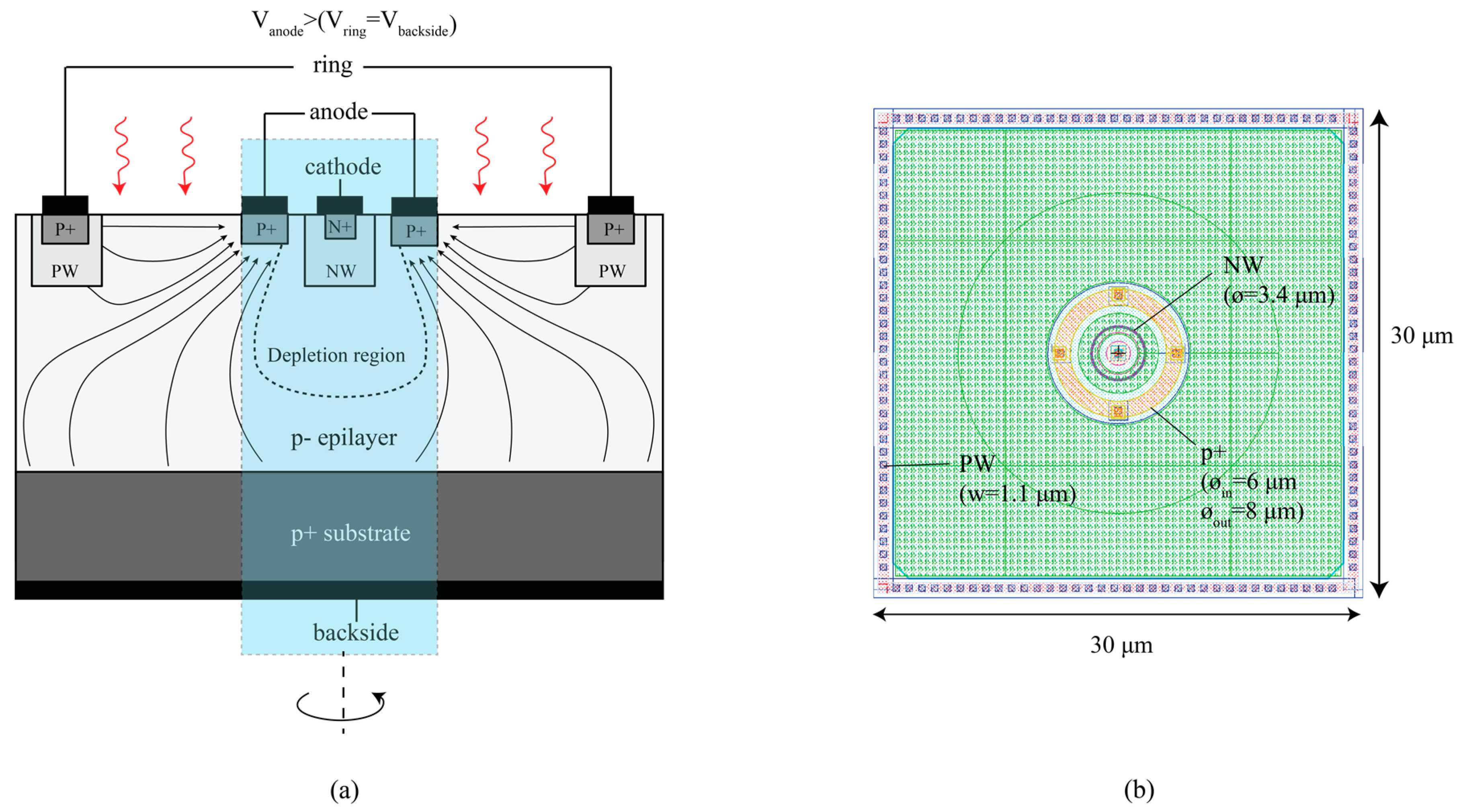
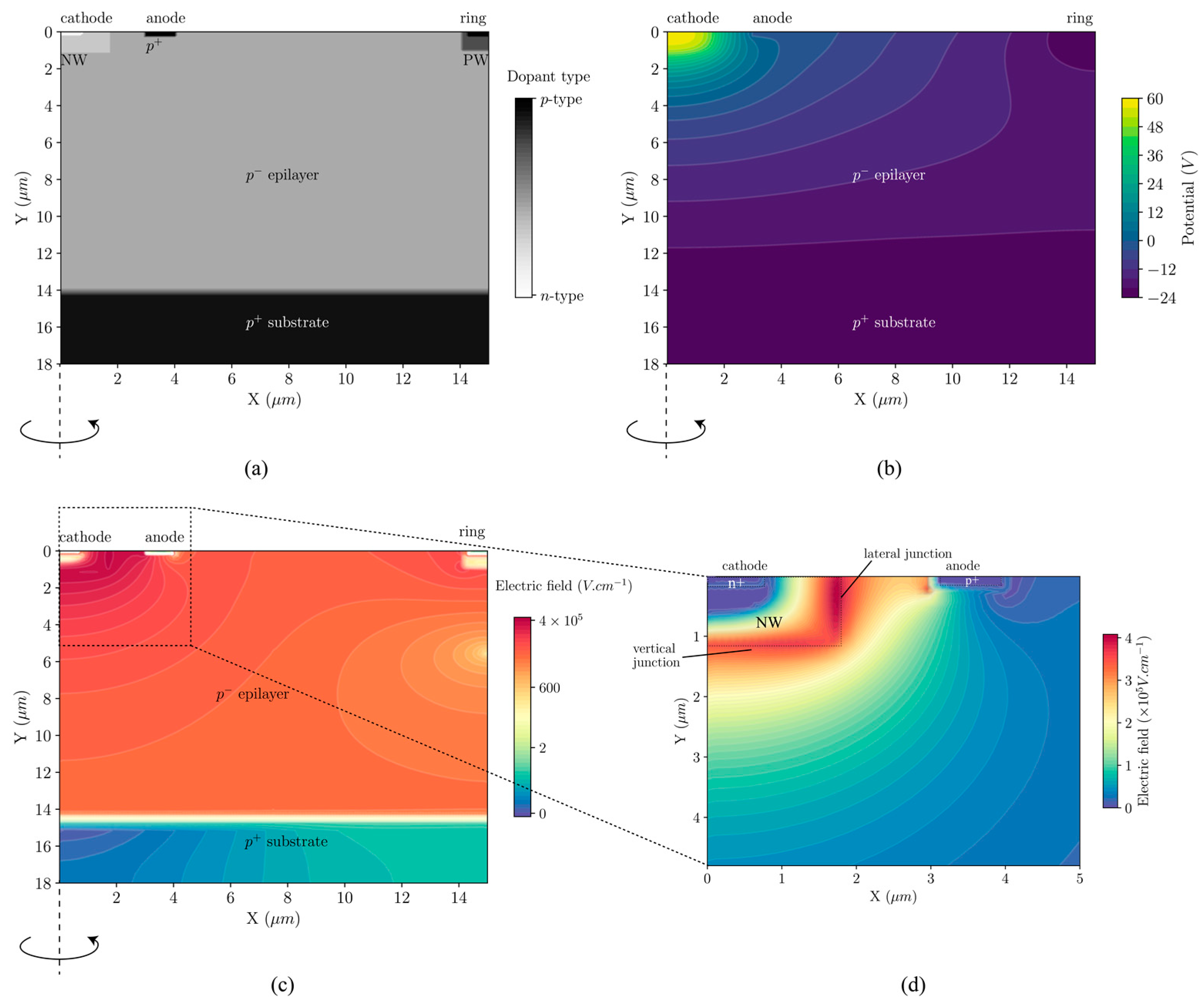

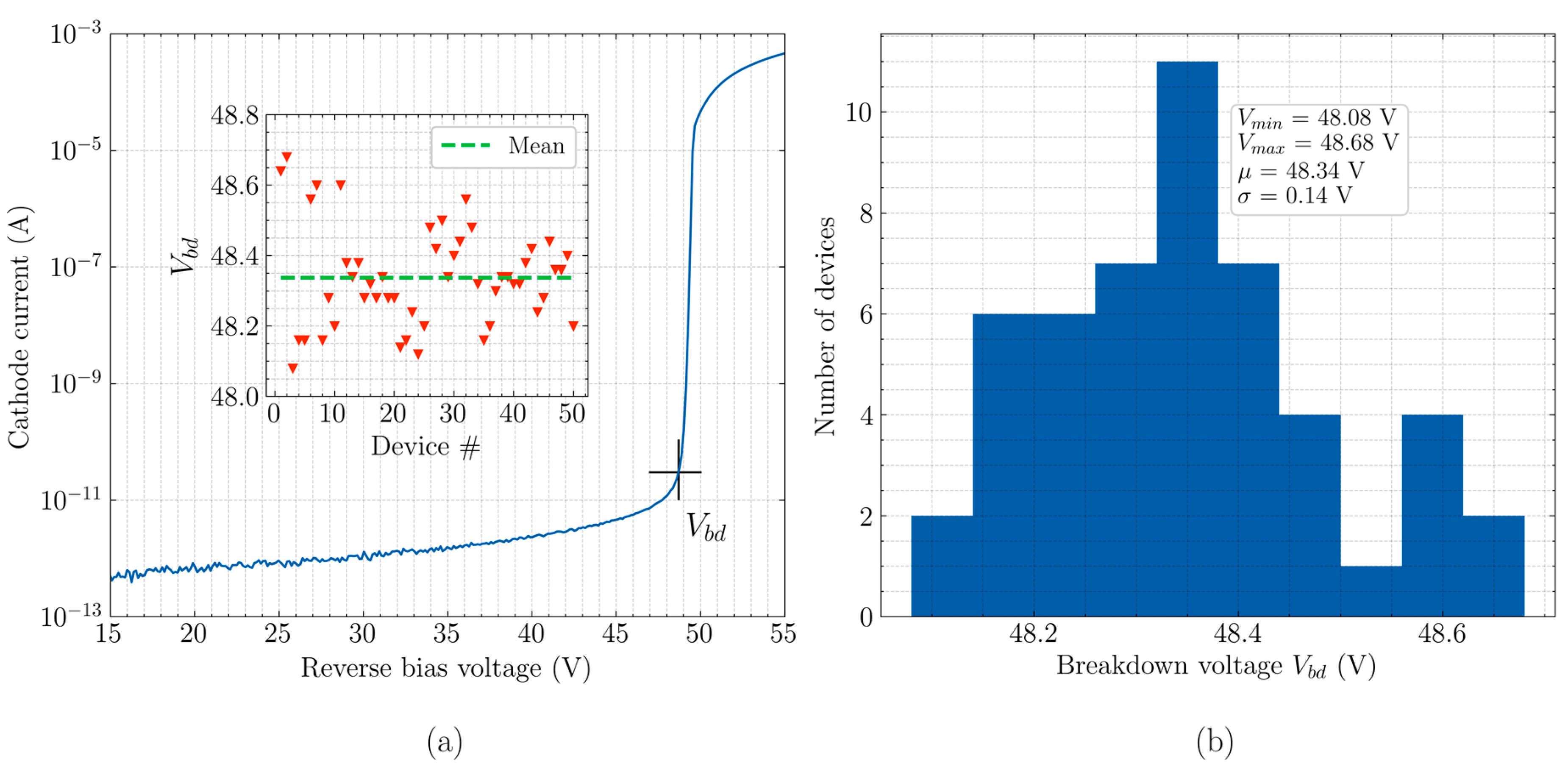

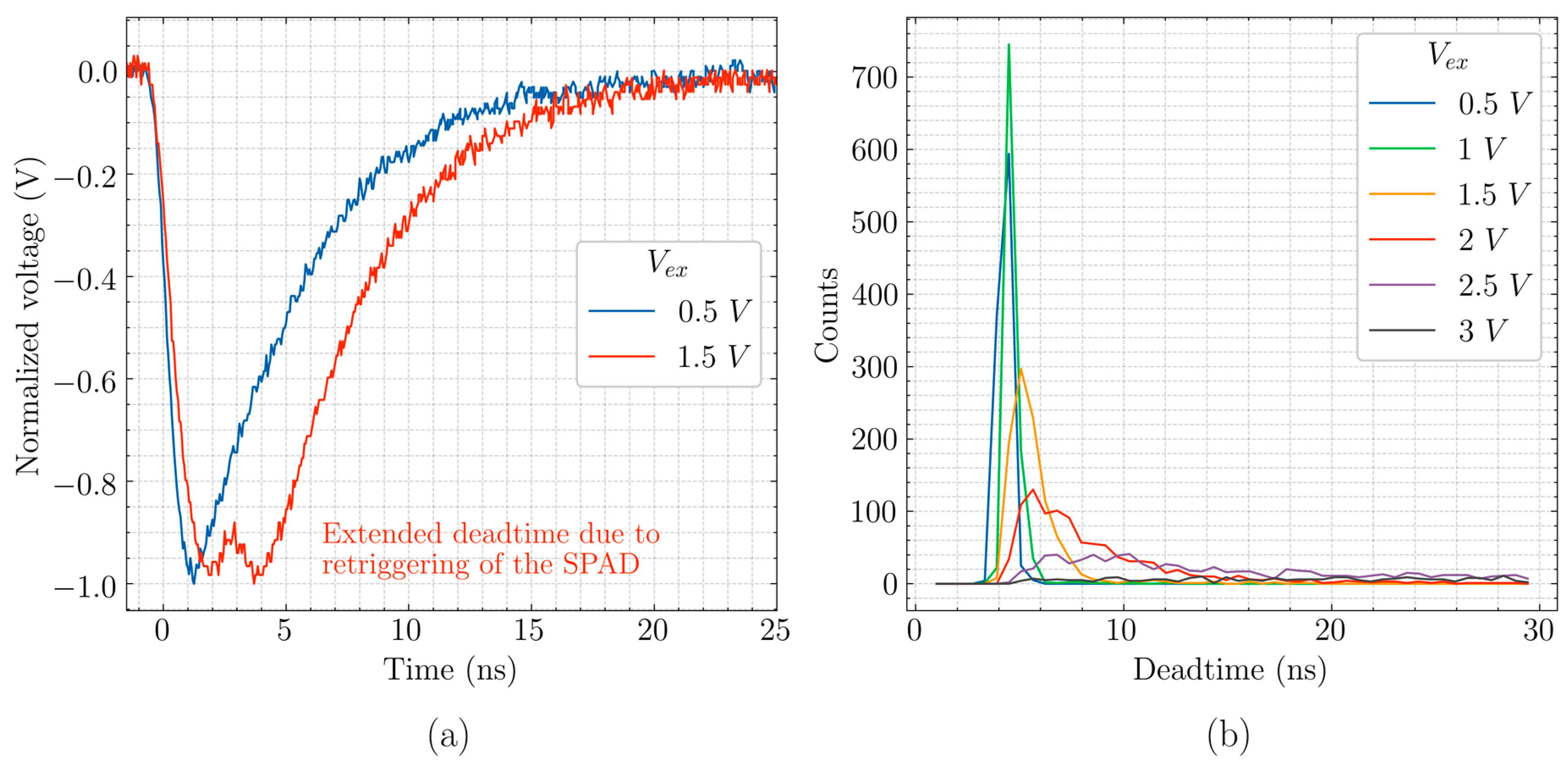
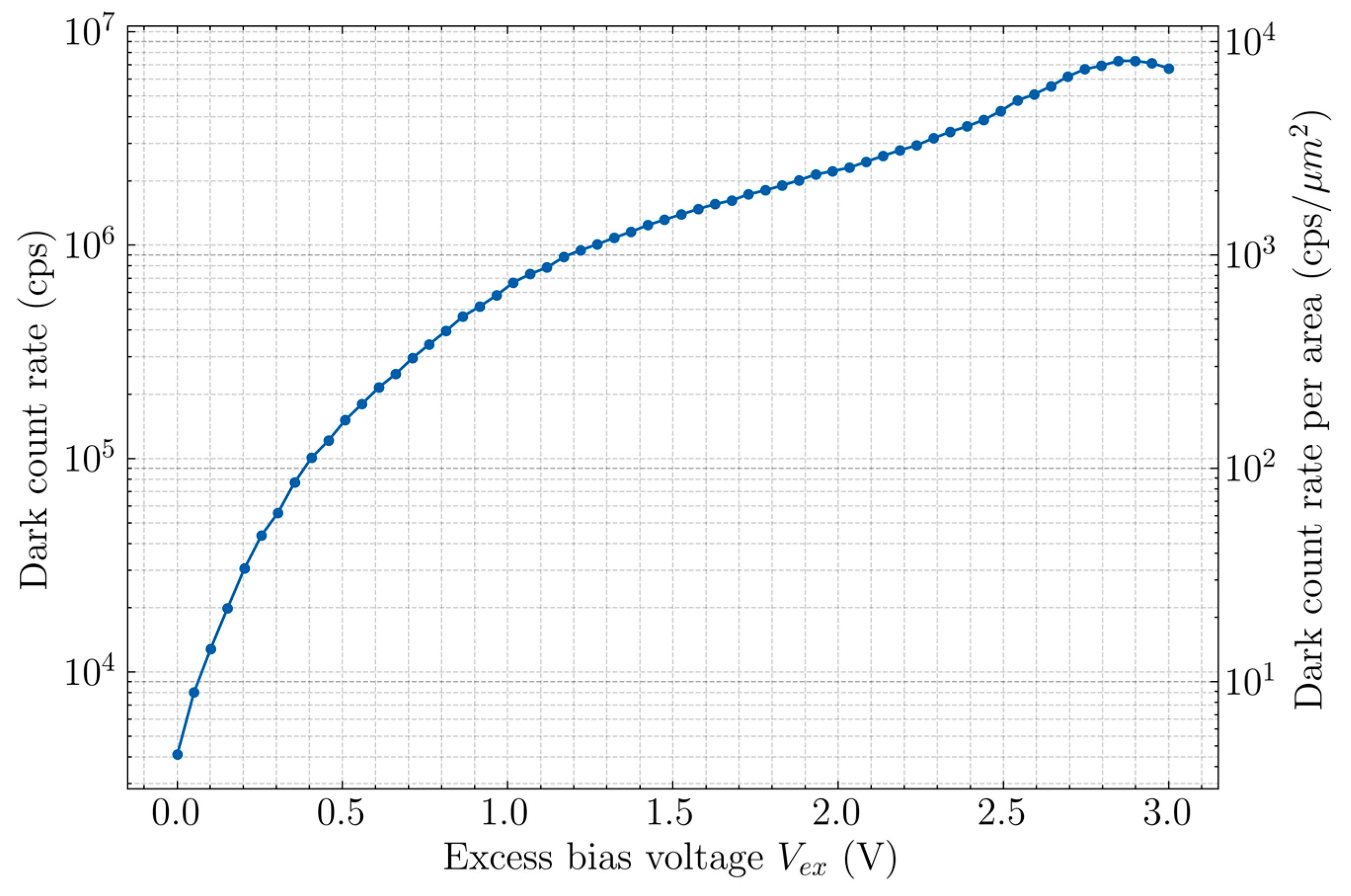
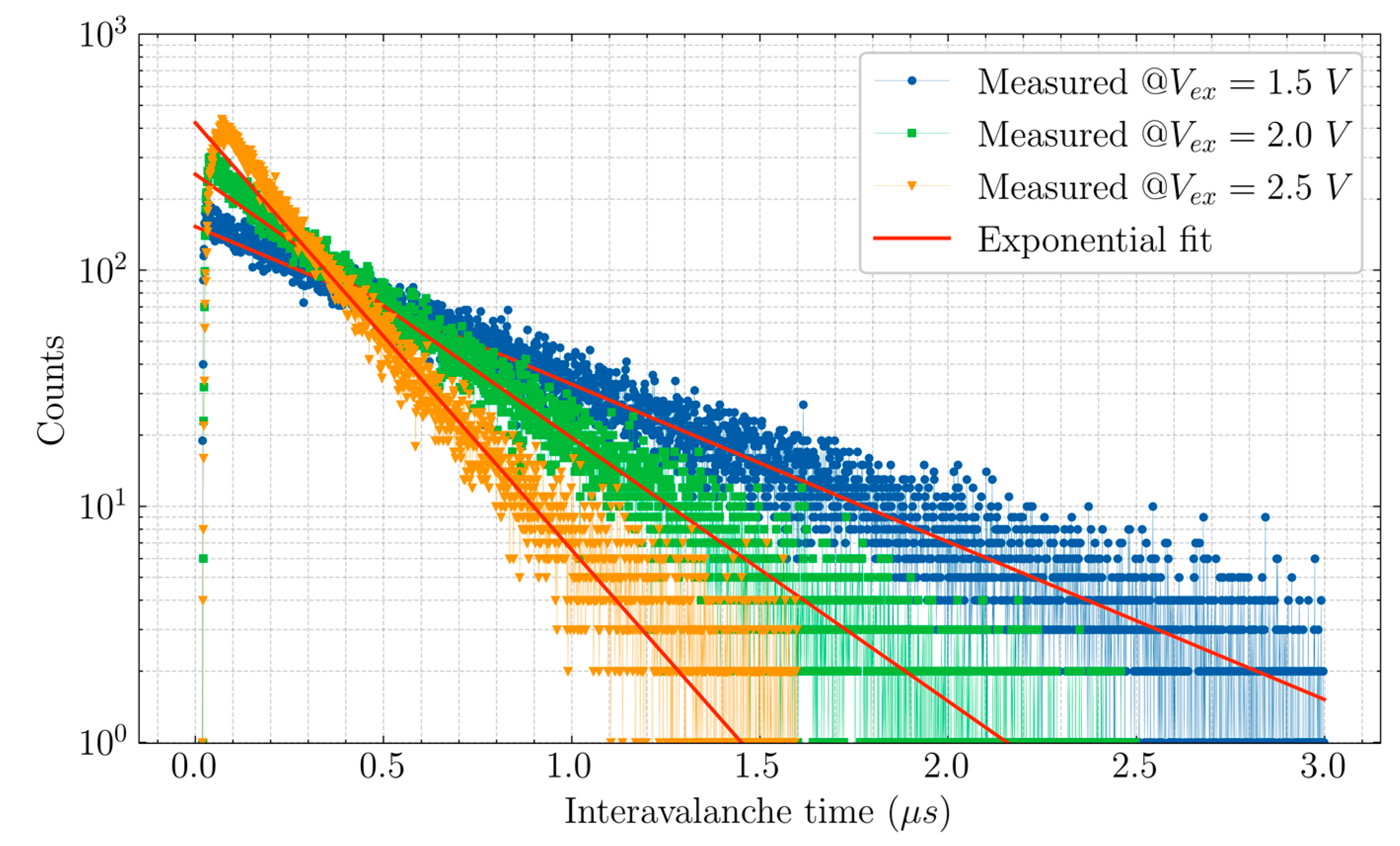
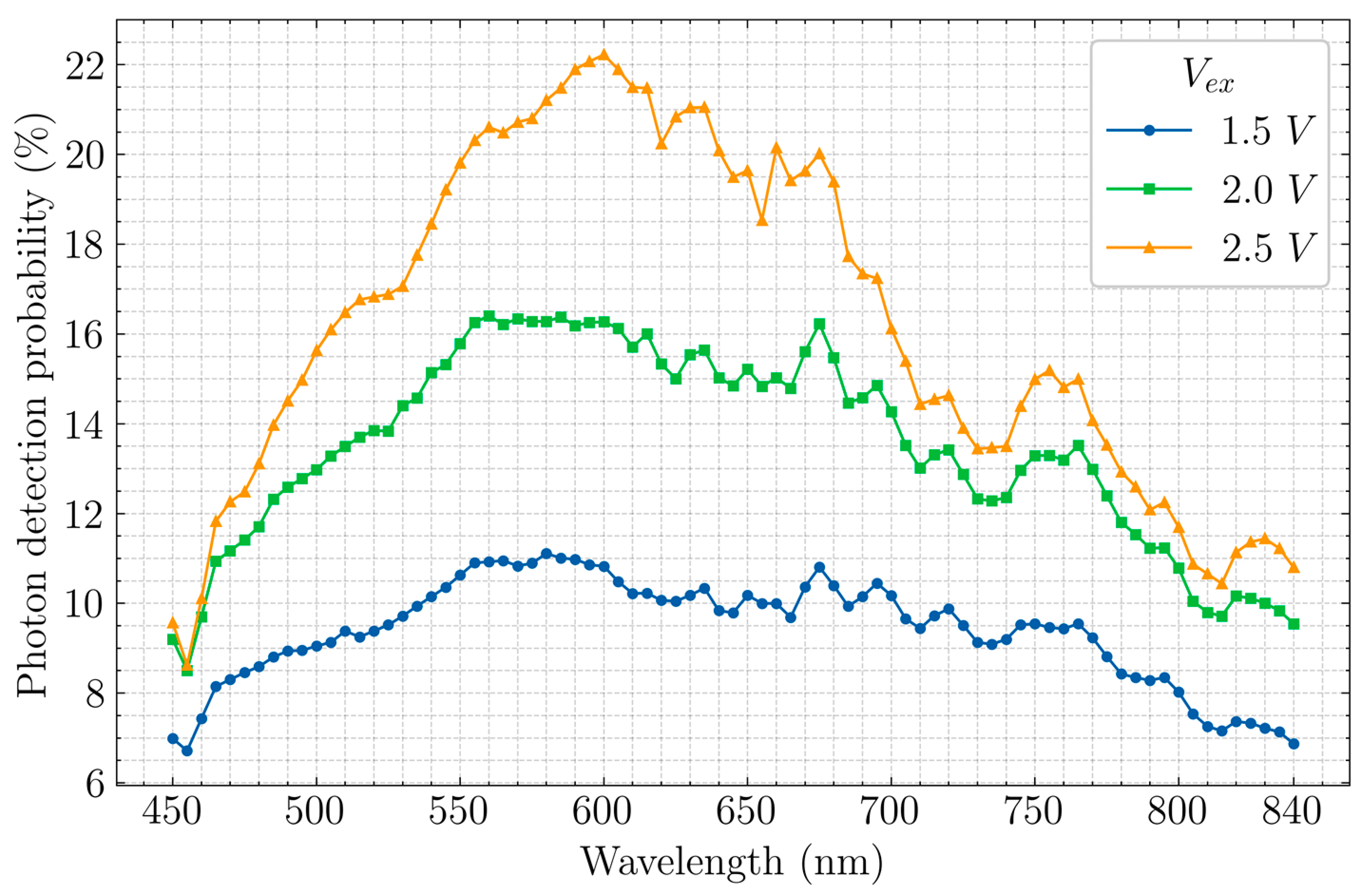
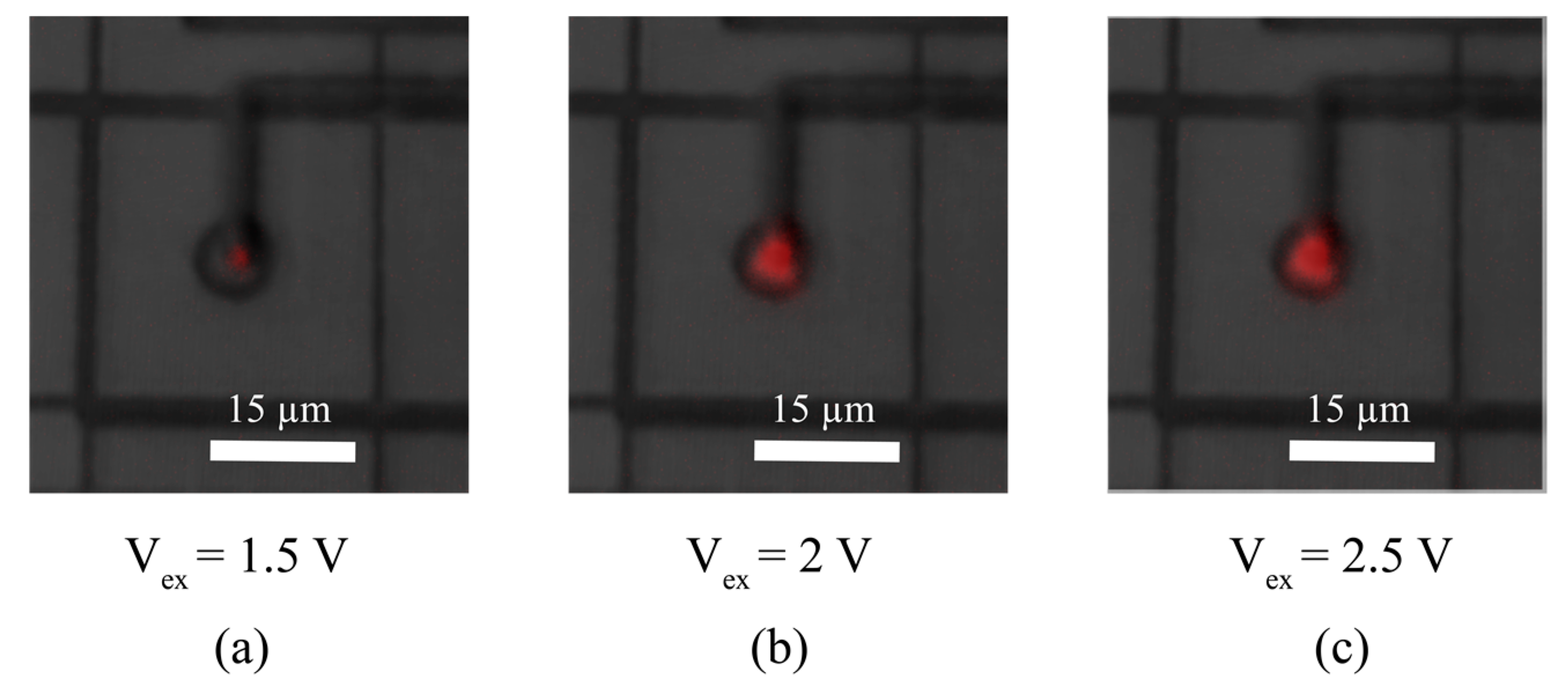

| Technology | 350 nm |
| Detection area (shape) | 30 × 30 µm2 (square) |
| p-n junction type | p+/p- epi/N-well |
| p-n junction geometry | cylindrical |
| Breakdown voltage | 48.34 V 1 |
| Excess bias voltage (Vex) | 2.5 V 1 |
| Timing jitter, FWHM [λ] | 220 ps, [650 nm] |
| PDPmax, [λ] | 22.2%, [600 nm] |
| Afterpulsing probability | ~13% |
| Quenching type | On-chip passive quenching (100 kΩ) |
| Ring current | 160 µA 1 |
| Power/pixel | 4 mW 1 |
Publisher’s Note: MDPI stays neutral with regard to jurisdictional claims in published maps and institutional affiliations. |
© 2020 by the authors. Licensee MDPI, Basel, Switzerland. This article is an open access article distributed under the terms and conditions of the Creative Commons Attribution (CC BY) license (http://creativecommons.org/licenses/by/4.0/).
Share and Cite
Jegannathan, G.; Van den Dries, T.; Kuijk, M. Current-Assisted SPAD with Improved p-n Junction and Enhanced NIR Performance. Sensors 2020, 20, 7105. https://doi.org/10.3390/s20247105
Jegannathan G, Van den Dries T, Kuijk M. Current-Assisted SPAD with Improved p-n Junction and Enhanced NIR Performance. Sensors. 2020; 20(24):7105. https://doi.org/10.3390/s20247105
Chicago/Turabian StyleJegannathan, Gobinath, Thomas Van den Dries, and Maarten Kuijk. 2020. "Current-Assisted SPAD with Improved p-n Junction and Enhanced NIR Performance" Sensors 20, no. 24: 7105. https://doi.org/10.3390/s20247105
APA StyleJegannathan, G., Van den Dries, T., & Kuijk, M. (2020). Current-Assisted SPAD with Improved p-n Junction and Enhanced NIR Performance. Sensors, 20(24), 7105. https://doi.org/10.3390/s20247105






